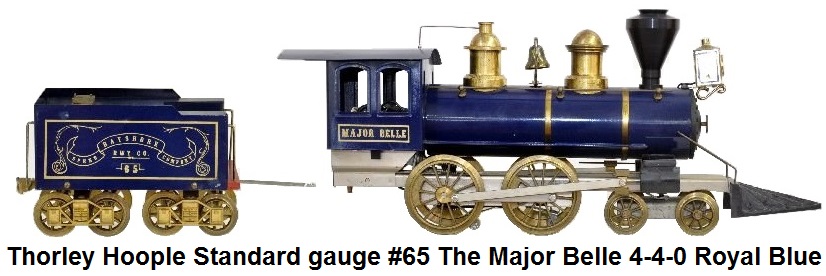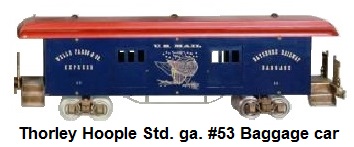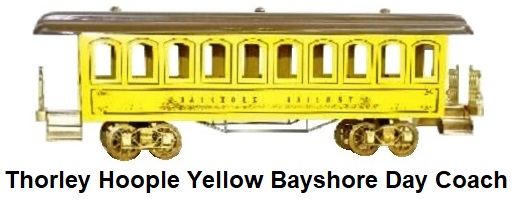History
 The Thorley Hoople Toy Company was a manufacturer of Standard gauge tinplate trains. The company was founded by George L.
'Tad' Cody, Jr. and based in Palo Alto, California. The line of toy trains produced were modeled after the steam locomotives
and coaches that ran on American railroads during the 19th century. They were well built, beautifully detailed, handcrafted
trains that, sadly, were only cataloged for a short period of time between 1965 and 1969. In addition to the Standard gauge
locomotives and passenger coaches, the 1967 catalog, which cost $1, depicted a #1 City Hall & Post Office Trolley car, cast
iron equipment including horse drawn carriages, horse drawn freight wagons, covered wagons, stagecoaches, horse drawn fire
engines, circus wagons and cannons.
The Thorley Hoople Toy Company was a manufacturer of Standard gauge tinplate trains. The company was founded by George L.
'Tad' Cody, Jr. and based in Palo Alto, California. The line of toy trains produced were modeled after the steam locomotives
and coaches that ran on American railroads during the 19th century. They were well built, beautifully detailed, handcrafted
trains that, sadly, were only cataloged for a short period of time between 1965 and 1969. In addition to the Standard gauge
locomotives and passenger coaches, the 1967 catalog, which cost $1, depicted a #1 City Hall & Post Office Trolley car, cast
iron equipment including horse drawn carriages, horse drawn freight wagons, covered wagons, stagecoaches, horse drawn fire
engines, circus wagons and cannons.
The Thorley Hoople Toy Co. came out with their Standard gauge 4-4-0 cabbage stack American type locomotive
in 1965. A 4-6-0 followed in 1968. Trains could be purchased in sets that consisted of the locomotives, tender, and 3 or 4
open platform passenger cars. The locomotive and car bodies were made using 16 and 24 gauge cold rolled steel. The
locomotives were primarily brass. The drive wheels were formed using sandcast brass and ran in machined bushings. The axle
drive was through bronze, and a precision worm gear was powered by an 18-volt universal motor. The
 boiler front, pilot and cylinders were made of aluminum. Superstructure fixtures of smoke stack, piping and domes were turned
from solid bar stock. The boiler domes weighed almost a full pound each. A manual reverse was included and the locos could
operate on any standard gauge layout. The 4-4-0 loco was numbered #65 to reflect the year it came out. The 4-6-0 loco was
given the number #89 which represented its year of origin 1968, but with the '68' turned upside down. The 4-4-0 was given the
name 'Major Belle' while the 4-6-0 was named 'Dr. George Cody'. The #65 locos came painted in either red or blue, and the #89
came in black. Some special order sets in custom color combinations of green and white were created.
boiler front, pilot and cylinders were made of aluminum. Superstructure fixtures of smoke stack, piping and domes were turned
from solid bar stock. The boiler domes weighed almost a full pound each. A manual reverse was included and the locos could
operate on any standard gauge layout. The 4-4-0 loco was numbered #65 to reflect the year it came out. The 4-6-0 loco was
given the number #89 which represented its year of origin 1968, but with the '68' turned upside down. The 4-4-0 was given the
name 'Major Belle' while the 4-6-0 was named 'Dr. George Cody'. The #65 locos came painted in either red or blue, and the #89
came in black. Some special order sets in custom color combinations of green and white were created.
Car construction features were of similar materials. Early cars had wood roofs, sheet steel sides, wood bottom,
squared off windows, Archbar type sand cast truck frames and wheels, and hand fabricated brass plated wire end railings. Initial
production and model sales uncovered issues with some of these manufacturing approaches and changes were made to improve the quality.
The later cars have sheet metal tops, arched windows with embossing, lost wax die-cast truck frames and wheels, and lost wax cast
handrails and end railings. All passenger cars had furnished interiors. The cars are roughly about the size of Lionel
Blue Comet cars. The initial passenger car issues were the #51 coach, #52 Combination, #53 Baggage, and #56 Palace car. The later
issues included the Governor Stanford and Bayshore coaches. These cars came in either yellow, blue, red or brown.

It was a very small operation and George Cody was the designer, manager, and secretary.
The Thorley Hoople Company's Palo Alto facility was not a self contained industrial complex situated under one roof. Cody beleived
that his company was more like the Harry Ives garage circa 1868. Ives toys were first made on contract using a multitude
of local suppliers in the northeast region of the United States. In a similar way, all of the Thorley Hoople parts were made
by an assortment of other manufacturers in their region. Charles Hotchkiss made some of the early Ives patterns and continued as a
master modelmaker. His Hoople counterpart was John Grant who made the pilot models and casting patterns. Sheet steel punches and dies as well as
wire dies and parts were made by Leo Kusber, Jr. son of the Leo Kusber, who thirty years earlier had made all the tooling
and non-screw machine parts for Rollin Lobaugh. Barry Lysaght, a gifted wood carver, made the models for
a whole train load of metal figures that rode the trains.
 Sets were produced in limited runs. A numbering sequence method was employed whereas a train numbered #1010 was the tenth train made.
It was planned that each loco frame would be stamped serially. This was accomplished for the first 25 sets or so, and then it became
overlooked. Hence, historically, only a few sets carry a stamped sequence number.
Sets were produced in limited runs. A numbering sequence method was employed whereas a train numbered #1010 was the tenth train made.
It was planned that each loco frame would be stamped serially. This was accomplished for the first 25 sets or so, and then it became
overlooked. Hence, historically, only a few sets carry a stamped sequence number.
There were endless difficulties with the small spoked brass wheels. It cost double the estimated machining cost in the
machine shop, as money was lost and it was a difficult time doing an adequate and consistent job. They retired their sand casting pattern
and redesigned the wheel for manufacture by Frank Harvey in a large screw machine. Form tools were used for handling the face cut on wheels.
Drills were used to bore the axle hole. The finished wheels were proclaimed to be the finest ever put on any tinplate train.
Tad Cody believed in the living-on of tinplate. Quotes from Mr. Cody's narrative in Thorley Hoople Train Company
catalogues state:
"For over a hundred years men have manufactured photographs, models, drawings and stories of trains
and about trains. Modelers have gone to lifetimes of effort to reproduce the most breathtaking detail of uncounted numbers of
locomotives and cars. Some have built scenery to form a dioramic glimpse into a piece of history they have never seen. No matter
how fine the detail there is never quite enouch and a feeling of 'almost' seems to persist".
"Yet a few models or toys by their lack of explicit detail convey as much or more of a real impression as
that produced by the most refined model. Perhaps this is why the toy train or tinplate train has survived even though we seem
to be able to reach ultimates of detail and scale."

Tad got involved in train production after he made the rounds at train meets and spoke with collectors and operators.
He learned that there were many who wished Standard gauge trains were still being made. This "sparked" his imagination. It motivated him
to plan and finally to manufacture archtype American tinplate trains - all American made. As a result, The Thorley Hoople Toy
Company organized In 1965. The name Thorley came from his Grandfather Cody, and the name Hoople from Major Hoople of comic strip fame.
Tad believed only Major Hoople would be capable of projecting such a grandiose scheme - Standard gauge for the mid 1960's. Tad was
known to have a unique sense of humor.
"It Is the purpose of this company to manufacture toy-train echoes of famous and fondly remembered
trains," claims the first Thorley Hoople catalogue issued in 1966. "We are dedicated to making better trains and not cheaper
trains. These are trains worthy of passing on to another generation." And from the second catalogue (1967), "....trains made of
steel and brass, American trains made with pride In the United States."
Tad knew that he could save money and reduce costs greatly if he opted to utilize cheaper materials such as plastic or zinc in his
products. He also knew that he could have manufacturing performed overseas to save on costs as well. Instead of taking that route,
he opted to adhere to an uncompromising approach and utilize quality materials and employ top of the line craftsmanship.
 At the time of the company's closure, a Standard gauge GG-1 locomotive was in development to head a Circus train. John Grant was
involved in engineering the truck articulation for a 23" long GG-1 and in solving the curve problems of 8-driver locomotives. A
set of flat cars for the 'Overland Circus' was in development that would carry a series of Circus loads consisting of cast wagons,
cast figures and cast circus animals to accompany the GG-1. The GG-1 was planned to bear Pennsylvania RR livery.
At the time of the company's closure, a Standard gauge GG-1 locomotive was in development to head a Circus train. John Grant was
involved in engineering the truck articulation for a 23" long GG-1 and in solving the curve problems of 8-driver locomotives. A
set of flat cars for the 'Overland Circus' was in development that would carry a series of Circus loads consisting of cast wagons,
cast figures and cast circus animals to accompany the GG-1. The GG-1 was planned to bear Pennsylvania RR livery.
Because of the limited quantities of Thorley Hoople trains manufactured, and the small window of only 5
years of production, these trains are very rare and very valuable. They are highly sought after by collectors, and when
located, sell for very high prices. Tad Cody, TCA #64-1114, passed away in 1994. He was a fine architect and many of his
residential work can be found around Palo Alto, CA and the surrounding communities.
Back To Top of Page

|






